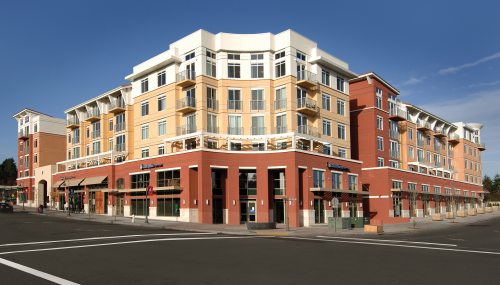
The Mercer
Architect: MVE & Partners
Owner: Dollar Development
ABC members: AAR Testing, BD Roofing, CHG Building Systems, Custom Sprinkler Corp., Hub International, Short Cressman & Burgess, Traffic Control Services, Tri State Plumbing, United Systems Mechanical
The Mercer is a mix of 150 luxury apartments and ground-floor retail that required extensive analysis to adhere to city guidelines. The project team collaborated several years prior to the start of construction to ensure its financial viability.
Because Express Construction knew significant jumps in the cost of materials and labor were inevitable, it negotiated with the city to get permits issued for excavation work and parking garage construction.
A big challenge came where the architect left the job five months after completing permit drawings. That left Express to manage the cast-in-place concrete building without the architect’s direction.
A geopier system was substituted for an auger-cast pile system. Using geopiers was ideal for the site’s questionable soil conditions and the owner saved money even after the cost of re-engineering the footings and foundation walls was figured in.
Many of the project’s concrete pours exceeded 1,000 cubic yards and included intricate footings, concrete walls and floor decks.
Since the project’s site had limited access and little storage space, its two-level garage was opened as soon as possible for material deliveries, storage and on-site parking.
Roofing began along with record-breaking rainfall. For nearly 45 days roofing crews were forced to work with sections of moveable, temporary shelters. Despite the adverse weather, crews installed 45,000 square feet of roofing without incident.
As roofing was nearly complete on the south sector, the owner requested a schedule change so that the project could be opened in phases starting with the south and east sectors — a radical departure from the original schedule that dictated the south sector as the last to be completed. To occupy the building under the new plan, the city required it be divided into three sectors, which did not correspond with the original design. That required the infrastructure — hot water, heating and cooling systems — be completed for the entire building first.
In the last five months of the project, 15 units were finished every 10 days, requiring up to 200 workers at a time. As each section of units was completed, they were turned over to the owner. The leasing activity was so robust that people were moving in during the last three months of construction.
There were no injuries or time-loss accidents recorded in the 32,353 hours worked on the job.